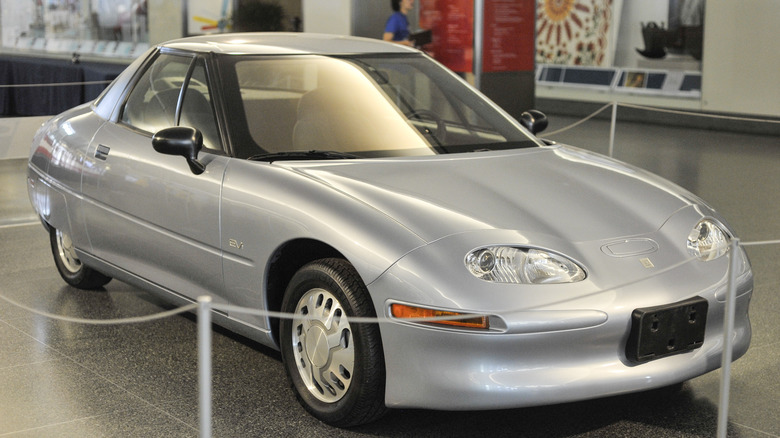Why The EV1 Was One Of The Biggest Flops In General Motors History
Long before Tesla dominated the electric car conversation or the Nissan Leaf was a feasible battery -powered car, there was the General Motors EV1.
Electric cars may still be a while away from universal adoption, but they've have made huge strides in a relatively short period of time. With instant torque and multiple motors, there are several EVs out today that can outperform gas-powered cars. But it was only recently that EVs offered any real edge over conventional cars, apart from freedom from the gas pump. There was a time when EVs were slow, heavy, and inefficient.
In 2022, it seems like nearly every large automaker is revealing a new EV on a daily basis. But in 1990, it was a huge deal when General Motors announced an electric car project, titled "Impact." The Impact concept was exciting — it was a sleek electric car with a somewhat usable range, in a market where that simply didn't exist. By the time the concept reached production for the 1997 model year, it was called the GM EV1. But enthusiasm melted the second drivers got behind the wheel. General Motors shot for the stars and missed completely. It was discontinued in 1999.
Not ready for the mass market
Looking like a HotWheels car that ended up in the microwave, the EV1's styling left a lot to be desired. It was tiny and odd looking from every angle. Reviews from the time noted that the back two wheels were closer together than the front pair. All the wacky styling decisions were made so the EV1 was as aerodynamically efficient as possible. Unlike the high-torque permanent magnet motors that power today's electric cars, the EV1 was driven by a single AC induction motor. Lithium battery technology was still in its infancy back in the 1990s, so GM opted for lead acid batteries to give the EV1 power. According to MotorTrend, the range was only about 70 to 90 miles.
General Motors never actually sold any EV1s in the traditional sense, as they were only available to lease in select Saturn dealerships in the Southwest United States (via Hagerty). After the three-year lease period was over in 1999, General Motors collected the entire production run, totaling a little over 1,000 cars and crushed them. Only a few models were saved and donated to museums and universities. According to Hagerty, GM wanted to avoid the hassle of customers dealing with aging batteries and to protect the EV1's design from corporate espionage.
After investing over a billion dollars, the EV1 was no more, and it would be another couple decades until automakers were ready to make another serious crack at an electric car.
